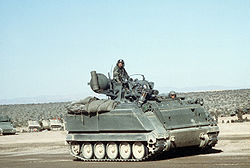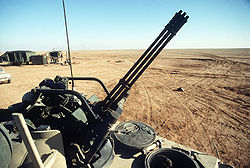
The M61 Vulcan is a hydraulically, electrically, or pneumatically driven, six-barrel, air-cooled, electrically fired Gatling-style rotary cannon which fires 20 mm × 102 mm rounds at an extremely high rate. The M61 and its derivatives have been the principal cannon armament of United States military fixed-wing aircraft for over sixty years.
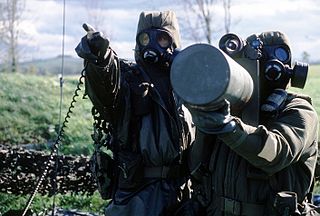
The Shorts Blowpipe is a man-portable (MANPADS) surface-to-air missile that was in use with the British Army and Royal Marines from 1975 to 1985. It also saw service in other military forces around the world. Most examples were retired by the mid-1990s. It is unique among MANPADS in that it is manually guided to its target with a small joystick, sending guidance corrections to the missile over a radio control link.

The M230 Cannon is a 30 mm (30×113 mm), single-barrel electrically-driven autocannon, using external electrical power to cycle the weapon between shots. It was designed and manufactured originally by Hughes Helicopters in Culver City, California. As of 2019, it is produced by Northrop Grumman Innovation Systems.

The Flugabwehrkanonenpanzer Gepard is an all-weather-capable German self-propelled anti-aircraft gun (SPAAG) based on the hull of the Leopard 1. It was developed in the 1960s, fielded in the 1970s, and has been upgraded several times with the latest electronics. It has been a cornerstone of the air defence of the German Army (Bundeswehr) and a number of other NATO countries.

The Avenger Air Defense System, designated AN/TWQ-1 under the Joint Electronics Type Designation System, is an American self-propelled surface-to-air missile system which provides mobile, short-range air defense protection for ground units against cruise missiles, unmanned aerial vehicles, low-flying fixed-wing aircraft, and helicopters.

The ZU-23-2, also known as ZU-23, is a Soviet towed 23×152 mm anti-aircraft twin-barreled autocannon. ZU stands for Zenitnaya Ustanovka – anti-aircraft mount. The GRAU index is 2A13.

The General Dynamics FIM-43 Redeye is a man-portable surface-to-air missile system. It uses passive infrared homing to track its target. Production began in 1962 and – in anticipation of the Redeye II, which later became the FIM-92 Stinger – ended in the early 1970s after about 85,000 rounds had been built. The Redeye was withdrawn gradually between 1982 and 1995 as the Stinger was deployed, though it remained in service with various armed forces of the world until quite recently, being supplied via the Foreign Military Sales program. It was initially banned from being sold overseas, to avoid missiles falling into the hands of terrorist organizations. However, after the export ban was lifted, the weapon was never actually used by terrorists against civil aircraft, in contrast with other MANPADS. While the Redeye and 9K32 Strela-2 (SA-7) were similar, the missiles were not identical. Nonetheless, the CIA concluded that the Soviet SA-7 had benefited from the Redeye's development.

The M247 Sergeant York DIVAD was a self-propelled anti-aircraft gun (SPAAG), developed by Ford Aerospace in the late 1970s. Based on the M48 Patton tank, it replaced the Patton's turret with a new one that featured twin radar-directed Bofors 40 mm rapid-fire guns. The vehicle was named after Sergeant Alvin York, a famous World War I hero.

The MIM-72A/M48 Chaparral is an American-made self-propelled surface-to-air missile system based on the AIM-9 Sidewinder air-to-air missile system. The launcher is based on the M113 family of vehicles. It entered service with the United States Army in 1969 and was phased out between 1990 and 1998. It was intended to be used along with the M163 VADS, the Vulcan ADS covering short-range short-time engagements, and the Chaparral for longer range use.
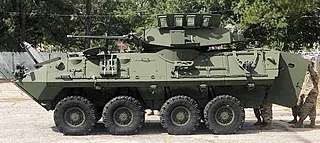
The LAV-25 is a member of the LAV II family. It is an eight-wheeled amphibious armored reconnaissance vehicle built by General Dynamics Land Systems and used by the United States Marine Corps and the United States Army.

The Machbet is an Israeli upgrade of the M163 Hovet self-propelled automatic anti-aircraft gun, based in turn on the M113 armored personnel carrier. In addition to the 20 mm M61 Vulcan rotary cannon it is armed with four FIM-92 Stinger surface-to-air missile launch tubes. The Machbet comes equipped with an upgraded tracking system and can establish a datalink with an external radar. The vehicle carries 1,800 rounds of 20 mm ammunition and 8 Stinger missiles. The Israeli Aircraft Industries (IAI) developed the Machbet in the mid-1990s. It underwent testing by the Israel Defense Forces (IDF) in 1997 and entered operational service in 1998 with the Israeli Air Force (IAF). The IAF was planning to convert all its Hovets to the newer Machbet configuration. Most of the Hovets have already been converted over to the Machbet.
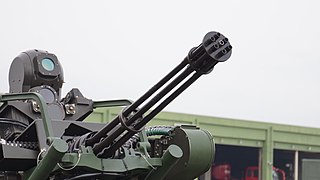
The M167 Vulcan Air Defense System (VADS) is a towed, short-range United States Army anti-aircraft gun designed to protect forward area combat elements and rear area critical assets. It was also used to protect U.S. Air Force warplane airfields and U.S. Army helicopter airfields. The heart of the M167 is the M168 Cannon, a variant of the M61 Vulcan 20×102 mm rapid-fire rotary cannon.

The Israeli Air Defense Command is the Israeli Air and Space Force unit responsible for the surface front of Israel's air defense, complementing the air defense provided by Fighter squadrons. Initially a part of the IDF Artillery Corps, since 1970 the Air Defense Command has been subordinate to the Israeli Air and Space Force.
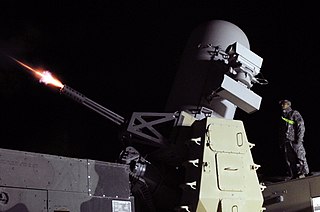
Counter rocket, artillery, and mortar, abbreviated C-RAM or counter-RAM, is a set of systems used to detect and/or destroy incoming rockets, artillery, and mortar rounds in the air before they hit their ground targets, or simply provide early warning.

The T249 Vigilante was a prototype 37 mm self-propelled anti-aircraft gun (SPAAG) designed as a replacement for the Bofors 40 mm gun and M42 Duster in US Army service. The system consisted of a 37 mm T250 six-barrel Gatling gun mounted on a lengthened M113 armored personnel carrier platform.

The General Dynamics Mauler was a self-propelled anti-aircraft missile system designed to a late 1950s US Army requirement for a system to combat low-flying high-performance tactical fighters and short-range ballistic missiles.

United States Army air defense relies on a range of ground launched missiles, ranging from hand held to vehicle mounted systems. The Air Defense Artillery is the branch that specializes in anti-aircraft weapons. In the US Army, these groups are composed of mainly air defense systems such as the PATRIOT Missile System, Terminal High Altitude Air Defense, and the Avenger Air Defense system which fires the FIM-92 Stinger missile.

The ZSU-23-4 "Shilka" is a lightly armored Soviet self-propelled, radar-guided anti-aircraft weapon system (SPAAG). It was superseded by the 9K22 Tunguska.


